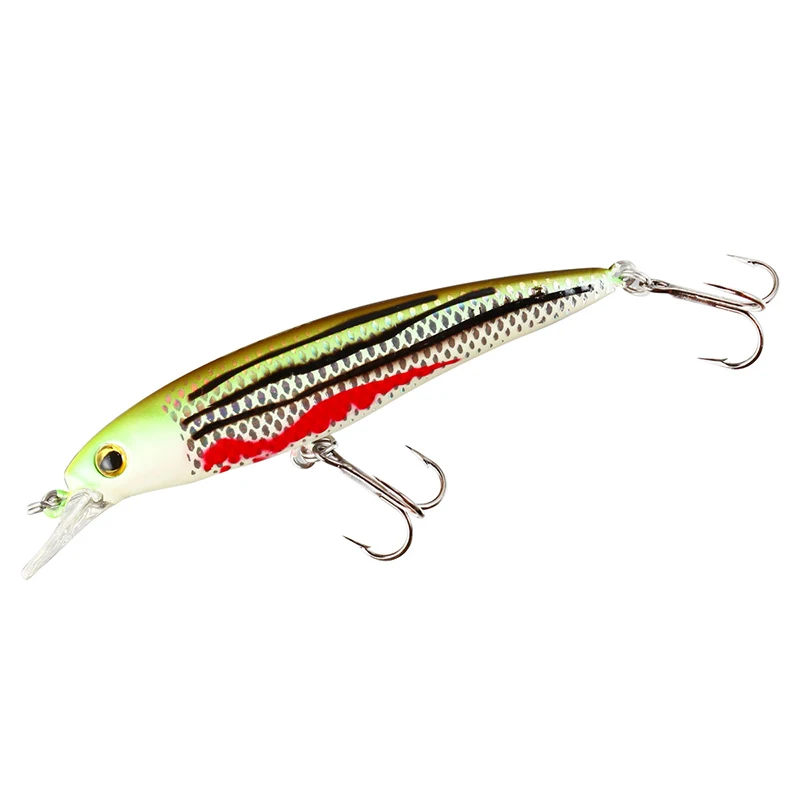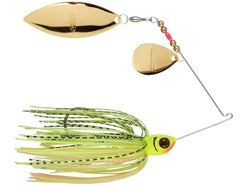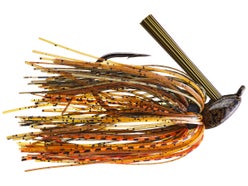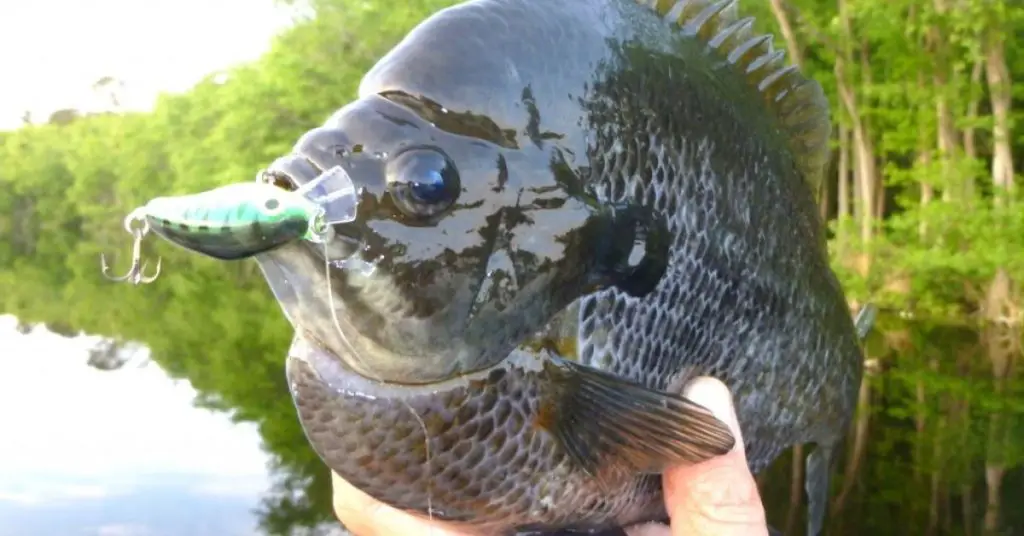If you’re looking to catch some bluegills, it’s important to use the right bait. In this blog post, we’ll share our favorite fishing lures for catching bluegills. We’ll also provide tips on how to fish for bluegills. Keep reading to learn more!
When To Fish Bluegills?
You can fish for bluegills any time of year, but the best times to find them are during their spring and summer spawn. You’ll know what I’m talking about if you see all these little guys huddled up undercover in some weeds- that’s when they’re close enough so we might as well get our tackle ready! There could be 50 eggs or more per nest; it really pays off looking around carefully before picking a spot because chances are good there will still be plenty left available at other locations too.
Where are Bluegills Found?
Bluegills are a common fish found in many types of water, including:
Deep lakes with plenty of vegetation around them; shallow rivers or streams where the riverbanks provide ample hiding spots for these little guys. Large ponds that have ducky trails through them!
Bluegills are a common fish found in shallow water. They like to feed off of the aquatic life and can often be spotted hiding among plants or logs, waiting for their next opportunity! A good place to find them would probably be under weed beds because that’s where they tend to eat most meals – so if you’re looking forward to trying out some new recipes then go ahead and snag yourself one (or five) today!.
Bluegills are common in shallow water. They tend to hide among the aquatic life, under plants or logs, and even inside weed beds where they feed on whatever food is available to them there. A great place I have found bluegills is near rocks because it’s hard not to see these little guys scurry around looking tasty!
How To Choose Fishing Lures For Bluegills
Artificial lures are a great way to catch these little guys, but be careful when using them. Make sure you use an artificial lure that resembles small fish or insects and tries not too hard because then it will seem like your trying too much!
The right bait can make all the difference. You need something that is going to be enticing enough for your fish, but not so big it catches their attention and scares them away from eating what you’re trying to teach them! Miniature crankbaits work well on smaller mouths with lures like mini flies or curly tail grubs- both will give off just enough vibration without being too flashy in coloration before They bite down hard around those sharp hooks at lightning speed because this isn’t one gadget they want anytime soon after getting caught once already today.
The soft plastic minnows and crappie jigs are said to be good lures for catching these bluegills. Other great attractors include split tail spinner blades, rooster tails as well any other small bait that can easily fit in one’s mouth like worms or grubs! If you’re having trouble hooking up with more than 1-2 per day then there may not just need better fishing technique but also some new equipment – which we’ve got here at.
When fishing for small fish, using lures can be difficult and often result in lost opportunities. A great alternative option is a bait that will always get your lure inside the indicator of their mouth if they happen not to take it right away!
Understanding Lure Features – Why It Is Very Important
Action Of Lures – How The Lure Behaves In The Water And How It Swims
Lures are designed to look and act like they’re actively struggling in the water. This is why, for example, reel-in actions on lures with a lip around it will make them swim erratically while stick bait needs straight reeling for effectiveness–although there’s some debate about this last point!
There’s a certain art to fishing with swimbaits. The lures have an action that is unlike anything found in nature, which makes them perfect for attracting the attention of big fish who are looking to eat something different than what they usually catch – especially if you’re using clear water locations where their pristine waters aren’t boggled-by colors or flashy patterns!
Lure Size – How Much Of A Difference It Actually Makes In Catching Big Fish
The size of your bait has a heavy influence on the kind and number of fish you catch. Bigger meals mean bigger lures, which in turn attract larger species like salmon or tuna (depending upon where they’re fishing). Smaller baits seem better suited for smaller water bodies – think fly rods versus conventional ones! That said though; it’s not always easy to find these smallish waters since most locals tend towards a big game rather than little.
You have to know that you’re not going to catch a huge fish every time, but if your bait is just right and the weather’s nice then maybe one great-looking tuna will come by. So keep those lures small because more than likely they’ll be catching them anyway!
Hooks – Why The Hooks Are The Most Important Parts On Your Fishing Lures
Hooks are a very overlooked aspect of fishing. The quality you choose will make all the difference in how well your line behaves, so don’t skimp on them! There are barbed hooks and those without; for most hard lures they utilize classic stainless steel treble hook designs with one point or two points depending upon what type it is (for example plastic). Barbless ones can be easier once hooked but might not hold onto their catch as well due to being less secure at first bite.
The Barbless Hook is a great hook for fishermen because it slides right out if you go too deep. If not properly removed from your hand, these hooks can cause injury and even infection which would be difficult to treat without proper equipment in the emergency kit contents! Exposed barbs on trees or grassy areas will get stuck easily while hidden ones won’t give them enough surface area so big fish love hiding here- that’s why I always make sure my fishing spots include some cover around frog stations where we are trying our best at catching something.
Hunger Vs. Reaction Strikes – The Difference Explained And Why It Does Matter
There are many reasons why a fish might hit your lure. They may be hungry and think you’re giving them something great, or irritated by the very presence of lures because it invades their personal space- regardless they’ll react to any type!
In order for this reaction from creatures with excellent hearing like ours (fish) to happen though – there must first exist a stimulus: usually, sound waves which cause some sort of distortion/anxiety within themselves as well as others around them such that when these frequencies reach our ears we interpret them mentally into what’s happening
You are sitting in silence, typing on your computer when all of a sudden you start to hear this loud rattle outside. After ignoring it for a while your ears start hurting and irritated by the sound; so much that getting up off the couch is necessary before seeing what’s causing such an annoying problem with no way around but unfortunately there isn’t anything inside either heights or depths – only open spaces between buildings where these things thrive.
Lure Buoyancy – The Distinction About The Sinking Rate Of Different Lures
Like real frogs, frog lures will stay on the water’s surface. Like crayfish and other underwater creatures that swim around in schools; these artificial bait fish are usually found at or near bottom depths where they imitate their natural prey with varying speeds and actions to draw out unsuspecting victims like shad (which can detect the scent from miles away) for easy capture by anglers waiting patiently below.
Frog style fishing has been used since ancient times as evidence suggests Romans cultivated lampreys rather than importing them from Europe – this practice continued until 1815 when Massachusetts became
Color Or Paint Pattern – Matching The Hatch And How Color Affects Your Lures
The color of your lure is important when fishing for crappie. It can make all the difference in getting that perfect bite, so don’t overlook this factor! If you’re after fresh or saltwater fish – try using colors with markings on them similar to what they would see in their natural environment; if we were talking about lakes and rivers then red might be best since it’s often found near these types of environments too-but note that each species has its own food preferences based off certain tones (e especially). And remember: never give a crawfish patterned bait because those animals have never seen one before… Instead, go ahead and use something realistic looking like.
If you want to get your lure noticed, use colors that are easier for others to see. When visibility in water goes down and fish can’t see what’s on the other side of their noses as easily- they’ll go after it! Why do lures come with such an array of strange hues then? Well, bright fluorescent shades stand out better up close due to both color contrast and also because these tones seem foreign or unnatural when looked at from afar–which gives them more attention span than darker ones would. Try using some lighter greys instead next time around; They won’t disappoint.
Friday night’s fish tale is all about how color can make a difference. Dark or bright colors allow the lure to be seen better in stained water, and weekend anglers who say that it doesn’t matter what you use for your lures don’t typically spend their time jigging with crappie rods hooks – any good fisherman knows this truth!
Top 5 Perfect Fishing Lures For Bluegills
POPPING LURES

If you’re looking for a lure that will get the attention of your bluegills, then look no further than these proven top water baits. There’s something about their action – whether it be colored or shapes-that just attracts those feisty “gills.”
Poppers are a very effective tool for anglers to use when fishing in more open water. The most common color of popper is white, but it can also be found in yellow or red with some bright hues mixed throughout – these colors help you see them among all those weeds and grasses! Some people prefer black because they don’t reflect light as other duller tones might do; however, I’ve never had much luck on my end while throwing one back after catching an abundant amount so far this summer season.
In order to be successful, you need a loud surface disturbance. This is where the size of its lip comes into play – it creates more noise when moved quickly across water or other surfaces! The best way for fishermen with these lures? “Pop” them near weeds/structures so they can short quick strokes emulating an insect struggling under foot while popping their lure above us (especially around lakes).
A J-style popper is a great way to catch bluegills on light lines. Use a 4-pound test line and tie it directly onto your rod with the improved clinch knot, making sure you trim off any extra cord before casting into deep water where there are lots of obstructions around like docks or other fish stands that might get in between them while they’re fighting over territory!
IMITATION MINNOWS

Hard plastic imitation minnows in the 2-inch size make for a great bluegill fishing lure. Just tie your line directly to its eyelet and twitch it back slowly, making short rapid strokes with plenty of authority while doing so – this should aim to emulate how injured fish swim around looking hopelessly unhealthy before dying!
Bluegills are hungry little bass that loves to chow down on anything they can get their lips around. This includes lures, spoons, and flies–even other fish! If you’re fishing for bluegills be sure to have some maggots or grubs at hand because these bait creatures will make your target inhale them before taking hold of any hook with ease; this makes unhooking easier than ever (though not always possible). Bigger species like peake does may find themselves aspire.
Minnow-type lures are best fished just above the weeds or in open water well away from the structure. These lures may be rendered semi weedless by replacing their standard treble hooks with single ones that have no attachment point for weeds at all!
Imitation minnows come in various “fish” patterns and colors including bluegill attracting red/white, black silver gold, etc…
SPINNERBAITS

The smallest versions of these popular bass baits are so effective for bluegills and that many anglers use them exclusively with great success. Available in sizes down to 1/32 ounce, the semi-weedless spinner blade lures should be worked through the structure to attract big catches hidden nearby – especially if you’re after those tiny creatures!
If you’re looking for the best way to catch bluegills, look no further than a spinnerbait! The patented design of this fisherman’s favorite is what makes it so deadly. You’ll want something light enough not too weighted down by your fishing line (or else risk losing sight on that big one), but heavy enough where its thrown off balance when pulled underwater by any amount or even just some Fiberglass leaders like I use sometimes if they’ve got stronger average tension throughout their length due.
JIGS

When fishing for bluegills, it’s all about the right size and weight. Leadhead jigs work great when fished on a light line in and around weeds with a 1/32 ounce crappie-type lure or grubbed hook at its head; they’re tough to beat!
If you’re looking for a jig head color (black, white, or natural) it’s not important; however grub bodies should be colorful and highly visible. Water clarity often dictates what kind of lures will work best with your bait selection- start by using either chartreuse green wire hair matted rigs were legal or black truth Bahamas minnow buckets before moving onto other colors based on preferences as desired!
Jigs are a great way to catch fish when you don’t want too much movement on your line. They can be fished just off the bottom and then worked their way up through 3-foot intervals depending on how deep it is that they’re fishing in. Bluegills tend not only to be found schooling below but also sulking near structures such as rocks or sunken wood which makes this tactic even more effective!
FLUTTER SPOONS

The flutter spoon is a fishing rod and reel combination used to catch game fish such as bass, crappie, or catfish. It has been around for over 100 years because of its effectiveness at attracting these aquatic animals with lures that dance in water clarity ranging from lighting up current conditions down near muddy banks all while making sure you’re not scaring away any potential prey!
The most common color schemes include gold/silver (which maximizes flash) but spoons can also come painted red on black if your preference leans more towards flashy-looking tackle rather than subtlety itself.
To get more bites on your bluegill, use a flutter spoon. These small lures have the unique action of making it hard for other fish to resist going after them because they’ll come back at you again and again! Plus if there are larger predators around that might take one look at this little guy before sinking their teeth into his flesh – which happens surprisingly often considering how light these things feel in comparison–you don’t want any part of Control Harmful Reactive.
When fishing with a flutter spoon, it’s best to fish solo because their highly irregular action makes them an inefficient choice for tandem rigs or dropper seat posts. However, this old-fashioned lure will keep speculating on bluegills as long you move your hands in front of them and make sure not too fast so they can see what type of bait is being offered! Use barbed hooks since then may be able to unhook themselves if caught while hunting over territory but also have the ability to return quickly below sea level.
Conclusion
If you’re looking to catch bluegill, using the right bait is essential. In this article, we’ve highlighted some of the best lures for bluegill fishing. We hope that this information helps you land your next big catch!


/outyr1w2gpswsx5j4na4wqbuzckd)





